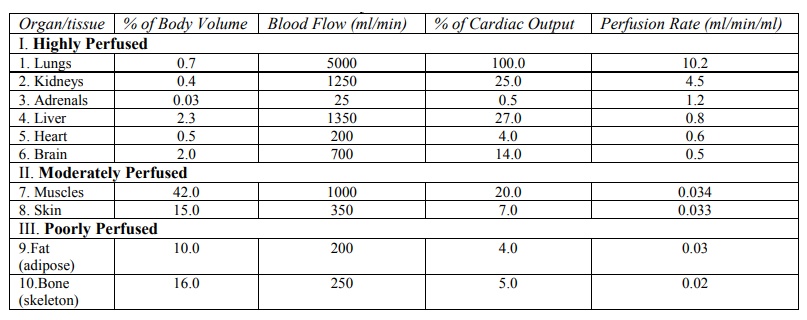Organ/Tissue Size and Perfusion Rate
| Home | | Biopharmaceutics and Pharmacokinetics |Chapter: Biopharmaceutics and Pharmacokinetics : Distribution of Drugs
Perfusion rate is defined as the volume of blood that flows per unit time per unit volume of the tissue.
ORGAN/TISSUE SIZE AND PERFUSION RATE
As discussed until now, distribution is permeability rate-limited in the
following cases:
a. When the drug under
consideration is ionic, polar or water-soluble.
b. Where the highly selective
physiologic barriers restrict the diffusion of such drugs to the inside of the
cell.
In contrast, distribution will be perfusion rate-limited when:
i. The drug is highly lipophilic.
ii. The membrane across which the
drug is supposed to diffuse is highly permeable such as those of the
capillaries and the muscles.
Whereas only highly lipophilic drugs such as
thiopental can cross the most selective of the barriers like the BBB, highly
permeable capillary wall permits passage of almost all drugs (except those
bound to plasma proteins). In both circumstances, the rate-limiting step is the
rate of blood flow or perfusion to the tissue. Greater the blood flow, faster
is the distribution.
Perfusion rate is defined as the volume of blood that flows per unit time per unit
volume of the tissue. It is expressed in ml/min/ml of the tissue. The perfusion rate of
various tissues is given in Table
3.3.
In Table 3.3, the various tissues are listed in
decreasing order of their perfusion rate which indicates the rapidity with
which the drug will be distributed to the tissues. Highly perfused tissues such
as lungs, kidneys, adrenal, liver, heart and brain are rapidly equilibrated
with lipid soluble drugs.
TABLE 3.3.
Relative Volume of Different Organs, Blood Flow and Perfusion Rate under
Basal Conditions Assuming the Total Body Volume to be 70 litres

If Kt/b is the tissue/blood partition
coefficient of drug then the first-order distribution rate constant, Kt,
is given by following equation:

The tissue distribution half-life is given by
equation:

The extent to which a drug is distributed in a
particular tissue or organ depends upon the size of the tissue (i.e. tissue
volume) and the tissue/blood partition coefficient of the drug. Consider the classic
example of thiopental. This lipophilic drug has a high tissue/blood partition
coefficient towards the brain and still higher for adipose tissue. Since the
brain (site of action) is a highly perfused organ, following i.v. injection,
thiopental readily diffuses into the brain showing a rapid onset of action.
Adipose tissue being poorly perfused, takes longer to get distributed with the
same drug. But as the concentration of thiopental in the adipose proceeds
towards equilibrium, the drug rapidly diffuses out of the brain and localizes
in the adipose tissue whose volume is more than 5 times that of brain and has
greater affinity for the drug. The result is rapid termination of action of
thiopental due to such a tissue redistribution.
Related Topics
